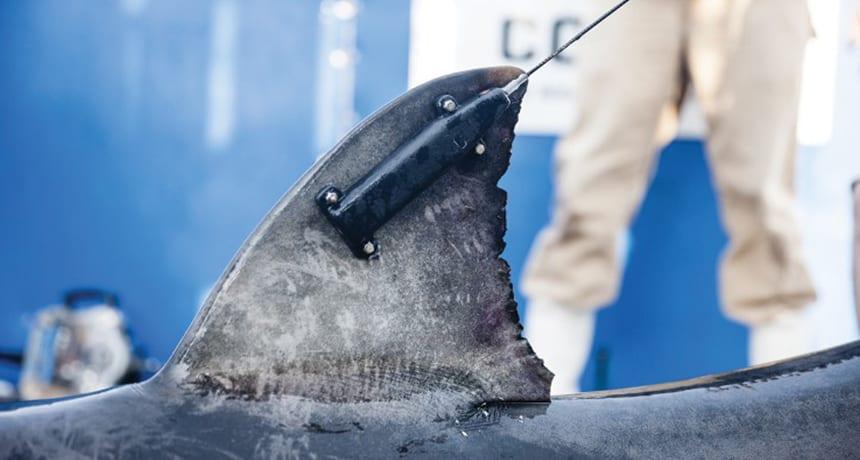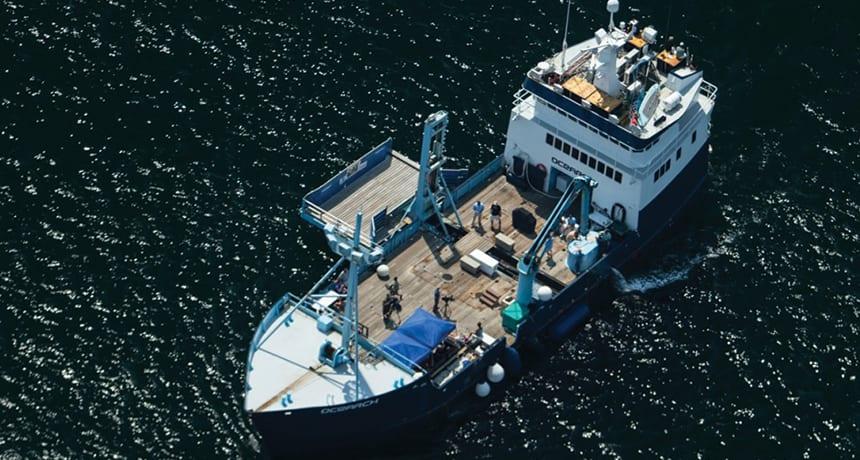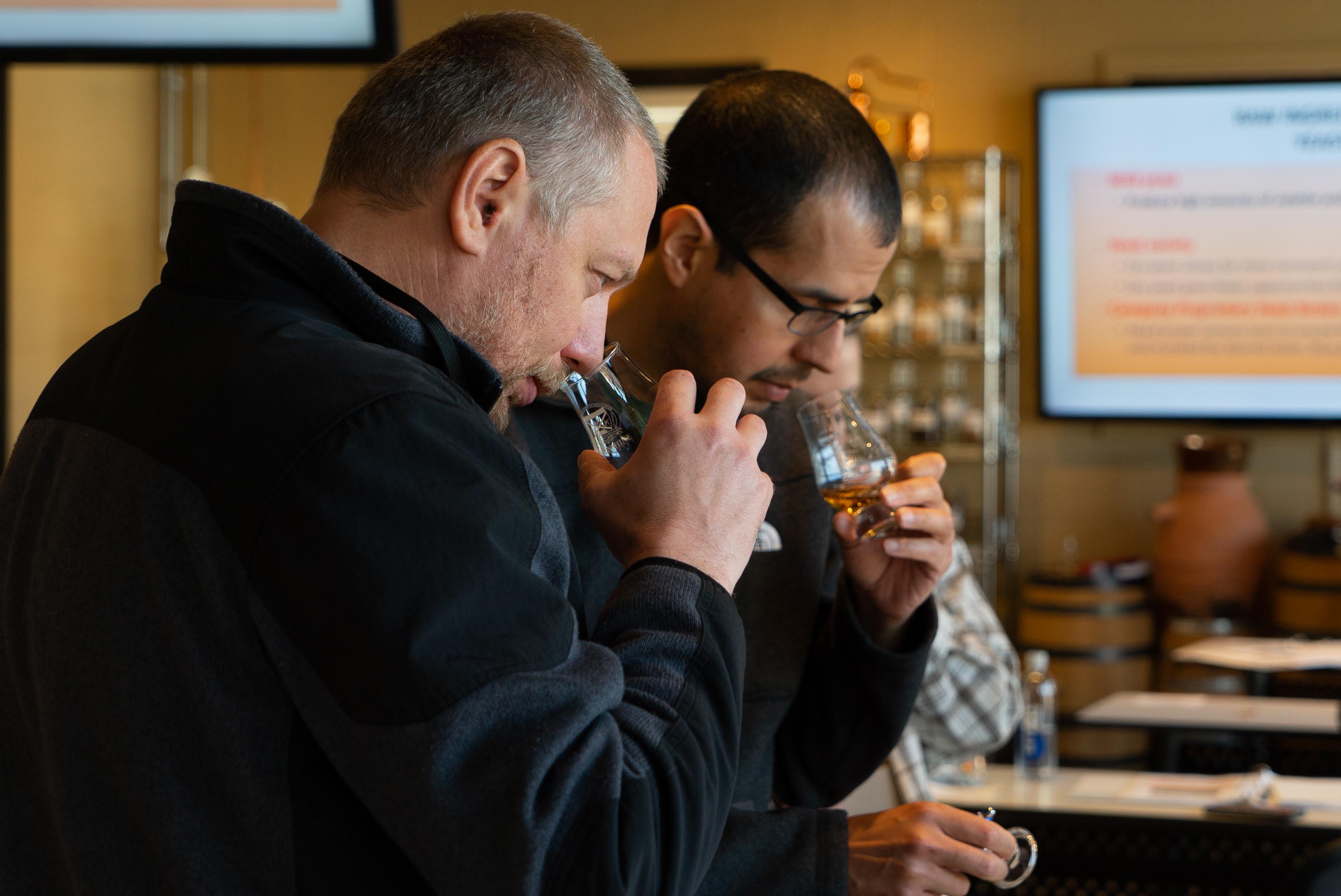
The Art of Non-Alcoholic Spirits
blog
For decades, spirits and cocktails have fostered a culture of craft, connection, and celebration. But over time, cocktail culture has evolved far beyond the buzz!

Rob Snow (OCEARCH) and used with permission of Robert HueterWritten by Tim M. Berra, PhD. To learn more about the author, scroll to the bottom of this page.
In January 2020, CBS 60 Minutes Overtime re-ran a previous story from September 2019 about tagging White Sharks off Cape Breton, Nova Scotia. The research vessel, MV Ocearch, is a 125-foot converted crab boat with a hydraulic platform that can be lowered off the starboard side, and then can lift up to 75,000 pounds (34,019 kg) back to deck level. When sharks are caught on a line, they are guided onto the submerged platform, which is then elevated above water level essentially beaching the fish. A hose is inserted into the captive shark's mouth so sea water can aerate the gills. Scientists can then get to work. They examine, measure, take blood and tissue samples, and tag the shark with acoustic and satellite transmitters. After about 15 minutes, the platform with the shark is submerged, and the shark is guided back into the ocean to freedom.
While watching the story, I was pleased to see that one of the scientists on board the vessel was a colleague, Dr. Bob Hueter, the Director of the Center for Shark Research at Mote Marine Laboratory in Sarasota, Florida, and Ocearch's Chief Science Advisor. I emailed Bob immediately after and told him I just saw him on 60 Minutes. I also told him about my recent book, Bourbon: What the Educated Drinker Should Know, since that was such a deviation from my usual work on fishes. As an ichthyologist writing about bourbon, I had inserted a brief account of osmoregulation in fishes, including the retention of urea by sharks, under the guise of the cliche "drinks like a fish." Bob later told me that he bought my bourbon book and liked it so much that he left it in Ocearch's onboard library for the crew to enjoy.
Jefferson's, recently acquired by Pernod Ricard, is not a distillery. They buy their whiskey from elsewhere and are very skilled at blending different sourced whiskeys of different ages into something special. In our email exchange Bob informed me that Jefferson's was one of the corporate sponsors of MV Ocearch and the shark research program. He also said that Ocearch carried four barrels of Jefferson's bourbon in the ship's hold during the research cruise. I immediately recognized that this must be one of the sources of Jefferson's Ocean, a bourbon whose claim to fame is that after eight years of traditional aging in Kentucky, it is further aged at sea. I already owned Jefferson's (82.3 proof, aged 6-12 years) and Jefferson's Reserve (90.2 proof, a blend of four bourbons), both of which I enjoy.
I had heard of Jefferson's Ocean, but wondered if this was just a gimmick. Now I had an excuse to justify spending the $100 for a bottle. Combining my two passions, it occurred to me that I should write something about this to inform "whiskey people" about shark biology and "shark people" about bourbon.

Rob Snow (OCEARCH) and used with permission of Robert Hueter
In the cold months I am usually chasing fish and avoiding crocodiles in the tropics of northern Australia, or I am writing books and scientific papers in my condo on the beach at Anna Maria Island, Florida — a quaint drinking village with a fishing problem, only 30 minutes from Mote Marine Laboratory & Aquarium.
This year I was in Florida, so I went to Longboat Key Liquors where the proprietor, Glen Schloneger, was pleased to sell me a bottle of Jefferson's Ocean Cask Strength (112 proof) from Voyage 14. Other expressions of Jefferson's Ocean are bottled at 90 proof and have been on different voyages of varying duration and turbulence. A typical voyage crosses the equator four times and visits over 30 ports on five continents.
Normally, the 53-gallon bourbon barrels are stored in a rickhouse and not moved until the master distiller decides the contents have reached the flavor profile for that brand. This may vary in different locations of the rickhouse because of different temperatures experienced at various levels of the building. For straight bourbon, this could be anywhere between 2-23 years, with a good average somewhere around 4-12 years and a sweet spot (my opinion) of about 8-12 years. As the whiskey, moves in and out of the wood propelled by temperature variations seasonally and diurnally, the various wood sugars that have been caramelized by barrel toasting and charring are dissolved in the bourbon. Remember that ethanol is an organic solvent. About 50-75% of the bourbon's flavor comes from the wood. The mash bill (grain recipe with a corn majority), yeast strain, and congeners remaining after distillation contribute additional flavors. The color of bourbon is 100% provided by the charred barrel.
Voyage 14 departed from Savannah, Georgia, in 2017. It encountered heavy seas and powerful winds 450 nautical miles north of the Panama Canal. After transiting the canal and crossing into the Pacific basin, Voyage 14 proceeded through five hurricane warnings.
If indeed there is any merit to aging bourbon on a ship, the bourbon from this pounding journey would be the one to sample. The idea, of course, is that the sloshing around of bourbon within the barrel while at sea would do something special to it because of the temperature fluctuation, salt air, and motion of the ship. That, my sharky colleagues, is why you were carrying barrels of bourbon on your research vessel.

by Rob Snow (OCEARCH) and used with permission of Robert Hueter
White Sharks, Carcharodon carcharias, occur worldwide in temperate to tropical seas usually nearshore. As adults, they feed on seals, sea lions, fishes, squids, and sometimes dead, floating whales. They may live 70 years. After decades of decline, their numbers along the east and west coasts of North America are now increasing. White Sharks have been protected in US waters since 1997, and their food supply has dramatically increased due to the Marine Mammal Protection Act, enacted in 1972.
Aboard the Ocearch, an acoustic tag is surgically implanted into the body cavity of a shark. It transmits to receivers suspended on a buoy or attached to the sea floor up and down the coastline. Each tag (and shark) has its own specific frequency so individuals can be identified. Every time tagged sharks pass near an acoustic receiver, their location is recorded. Water temperature, depth, and swimming speed are also transmitted and stored on the receiver. The researchers can then download these data onto a computer and plot the movement of the tagged sharks. The battery life of these tags is about 10 years.
Sharks worked up onboard Ocearch also gets a second type of tag that is linked to satellites. Called a SPOT (Smart Position & Temperature) tag, this transmitter is attached to the shark's first dorsal fin by drilling holes with an electric drill and mounting the tag with 2-4 bolts. Think of it as a sort of an "ear piercing"; the shark experiences no pain with this fin tag. The tag has an antenna and when the shark's fin is above the water surface with a satellite overhead, it transmits the location to the researchers via the satellite in near-real time. The batteries of this tag last up to five years.
The movements of White Sharks as large as 16 feet (c. 5 m) and 3,500 lbs. (c. 1,600 kg) have been recorded. Ocearch has tagged close to 60 White Sharks so far in the Northwest Atlantic Ocean —and more in other oceans — and some have made dives as deep at 3,000 feet (914 m). Where and when do they give birth? Do they make a pupping or seasonal migration? How far offshore do they normally occur? How far do they roam? Do they show site fidelity to a place? These are just a few of the questions the tagging program is beginning to answer. The reader is urged to go to the Tracker at www.ocearch.org to see these satellite data tracks for themselves.
To my bourbon buddies, this advancement of knowledge of the biology of a magnificent predator is a welcome byproduct of the production of an excellent bourbon by a company with a civic conscience. As Benjamin Franklin is alleged to have said, it is possible "to do well by doing good."

Author, Tim M. Berra / Jo McCulty, courtesy of OSU Alumni Magazine
Professional whiskey tasting is a skill honed by exposure to sensory training and years of practice. The average whiskey enthusiast can get proficient eventually, but not overnight, nor by solely reading a book. Women tend to be better whiskey sensors than men because they have 49 percent more neurons in the olfactory lobes of the brain based on a post-mortem study.
Regardless, I am not a big fan of tasting notes simply because everyone's sense of taste is specific to them and their personal experiences. Just because someone records vanilla, cinnamon, banana, oak, grass or any of the hundreds of sweet aromatics, spice, fruit, floral, wood or grain notes, does not mean that you will or should taste these flavors. On the other hand, ratings — such as 50-100 points or a 1-4-star system — do give an opinion of relative desirability according to that taster. If you follow a certain taster and read reviews of many whiskeys by that person, you come to recognize that you generally agree or disagree with that person's evaluations. If they like it, you probably will too. So, if your favorite writer gives a whiskey 90 points or three stars, it is probably worth trying. If the whiskey earns 60 points or 1 star, fuhgeddaboudit. You can find tasting notes and rankings from three prominent whiskey writers in books by Reigler & Veach (2018) and Risen (2015).
With that being said, here is how I approached tasting. I had my wife pour 15 ml (0.5 oz) of the three Jefferson's expressions I own (Jefferson's 82.3 proof, Jefferson's Reserve 90.2 proof, and Jefferson's Ocean Cask Strength 112 proof), plus one extra sample of one of the three. Only she knew what was in each numbered Glencairn glass. I tasted the four samples against each other, took notes, and wrote down a score. I repeated this routine five times over the course of two months for a total of 20 samples. The first sips were neat, then I added 2 ml of water or more as necessary; you may have heard the saying, "a really bad whiskey needs water and a really good whiskey deserves it." Jefferson's (82.3 proof) color is rather pale compared to the deep rich auburn of the other two expressions, so the glasses were set on a walnut-stained shelf for each tasting session, effectively blocking the color clue, however, its lower proof was obvious.
My goal was not to guess which sample was which, but to determine which expression I preferred and decide if I could taste any special characteristics of Ocean. I used a point system (stars) where 1 is drinkable, 2 is good, 3 is very good, 3.5 is excellent, and 4 is superb. For comparison, such generally available bourbons as Buffalo Trace, Elijah Craig Small Batch, and Evan Williams Single Barrel are very good to me, and Blanton's and Woodford Reserve Double Oaked are superb to my palate. You, or course, may think otherwise.
Jefferson's (82.3 proof) received an average of 3.1 points (stars) for six samples. Jefferson's Reserve (90.2 proof) earned 3.4 points as an average for seven samples, and Jefferson's Ocean Voyage 14 Cask Strength (112 proof) garnered 3.7 points on average for seven samples. Clearly, I preferred Ocean, but not by much over Reserve. Tasting is such a personal matter and if one factors price into the comparison, the assessment is even more individualized. In Ohio, a 750 ml bottle of Jefferson's Reserve (90.2 proof) sells for $50 and Jefferson's Ocean Cask Strength (112 proof) costs $95. Is the taste difference worth the cost difference? I can't answer that for you. With Ocean, you get a cool story, but is that worth an extra $45? My opinion is no. I'm happy with Reserve and the savings is nearly the price of a second bottle.
I correctly identified Ocean six of the seven times it was served to me and Reserve five of six times. My notes for Ocean emphasize complexity, depth, and richness of taste which are enhanced with the addition of water that tones down the high proof and its heat. The same notes apply to Reserve, but less water is needed. Jefferson's (82.3 proof) is fine for sipping without water but is a bit "mild" on flavor compared to the other two expressions. I did not smell or taste any special maritime quality with Ocean, but Risen and Reigler & Veach mentioned some form of brininess in either nose or palate. Risen does mention the possibility this could be psychosomatic.
Written by Tim M. Berra, PhD, and Executive Bourbon Steward.
About the Author
Dr. Tim M. Berra studies sharks and drinks whiskey. Berra received a PhD in Biology from Tulane University and is Academy Professor and Professor Emeritus of Evolution, Ecology & Organismal Biology at The Ohio State University. He is a three-time recipient of Fulbright Fellowships to Australia and the author of nine books and more than 85 scientific papers. He holds concurrent positions as a university professorial fellow at Charles Darwin University and research associate at the Museum and Art Gallery of the Northern Territory, Darwin, Australia. He is an Executive Bourbon Steward and member of the Stave & Thief Society. Tim currently has about 175 whiskeys in his glass menagerie. His latest book is Bourbon: What the Educated Drinker Should Know. Dr. Berra's other publications can be viewed on his OSU website.

blog
For decades, spirits and cocktails have fostered a culture of craft, connection, and celebration. But over time, cocktail culture has evolved far beyond the buzz!

blog
Those that are familiar with the process of crafting distilled spirits may also be familiar with the 10 common congeners that are created during fermentation, and honed during the distillation run. Each congener has its own distinct personality, rendering unique tastes and aromas to the finished spirit.

blog
So, you want to start distilling with freshly milled grain. Maybe you're tired of paying top dollar for the pre-milled stuff from the malt distributor, and you're ready to invest in the quality, efficiency, and bulk pricing that comes with milling your own whole grain. But where do you start?